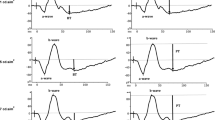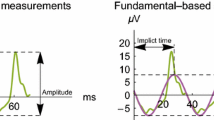Abstract
Numerous studies have demonstrated the ability of focal ERGs to diagnose abnormally functioning maculae in the absence of funduscopic and angiographic signs, as well as to confirm diagnoses of clinically suspected macular disease. We present normative data on the second commercially available focal ERG stimulator (FCS-500, LKC Technologies), which may be added to the standard full field ERG systems currently used in many laboratories. The stimulator uses a monocular indirect ophthalmoscope to present a 5° white stimulus flickering at 31.25 Hz in a 20° background field. We have established a range of normal amplitudes (747–3000 nV) and implicit times (30.5–37.5 ms) for the instrument based on tests of 45 eyes of 45 normal patients. To confirm the validity of this test for diagnosis of ocular dysfunction we compared these normals to 46 eyes of 46 patients with macular disease and decreased acuity, and to 49 eyes of 49 patients with retinitis pigmentosa. Using Focal ERG amplitude alone, we found overall accuracy of 85% in diagnosing macular disease associated with decreased acuity. These findings confirm the validity and efficacy of the system we have evaluated.
Similar content being viewed by others
REFERENCES
Miyake Y, Ichikawa K, Shiose Y, Kawase Y. Hereditary macular dystrophy without visible fundus abnormality. Am J Ophthalmol 1989; 108(3): 292–9.
Fish GE, Birch DG, Fuller DG, Straach R Fish. A comparison of visual function tests in eyes with maculopathy. Ophthalmology 1986; 93(9): 1177–82.
Matthews GP, Sandberg MA, Berson EL. Foveal cone electroretinograms in patients with central visual loss of unexplained etiology. Arch Ophthalmol 1992; 110(11): 1568–70.
Jacobson SG, Sandberg MA, Effron MH, Berson EL. Foveal cone electroretinograms in strabismic amblyopia: comparison with juvenile macular degeneration, macular scars, and optic atrophy. Trans Ophthalmol Soc UK 1979; 99(3): 353–6.
Fish GE, Birch DG. The focal electroretinogram in the clinical assessment of macular disease. Ophthalmology 1989; 96(1): 109–14.
Biersdorf WR. The clinical utility of the foveal electroretinogram: a review. Doc Ophthalmol 1989; 73(4): 313–25.
Weiner A, Sandberg MA. Normal change in the foveal cone ERG with increasing duration of light exposure. Invest Ophthalmol Vis Sci 1991; 32(10): 2842–5.
Severns M, Johnson M, Merritt S. Automated estimation of implicit time and amplitude from the flicker electroretinogram. Appl Opt 1991; 30: 2106–2112.
Marmor M, Zrenner E. Standard for clinical electroretinography (1994 update). Doc Ophthalmol 1995 89(3): 199–210.
Author information
Authors and Affiliations
Rights and permissions
About this article
Cite this article
Lyons, J.S., Sapper, D.J. Evaluation of the LKC stimulator for focal ERG testing. Doc Ophthalmol 103, 163–173 (2001). https://doi.org/10.1023/A:1012421111342
Issue Date:
DOI: https://doi.org/10.1023/A:1012421111342




